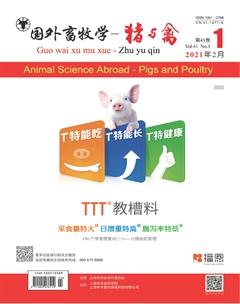非洲豬瘟病毒免疫逃逸特性
謝春芳 于瑞嵩 董世娟 陳冰清
摘? 要:非洲豬瘟病毒(African Swine Fever Virus,ASFV)主要感染豬單核細胞和巨噬細胞等免疫淋巴細胞,通常會導致豬出現急性出血癥狀,體溫升高,死亡率達100%。豬在人類食物鏈中的地位不可替代,而且豬的生理結構、免疫特性與人類相似,因此非洲豬瘟的免疫防控問題與人類社會環境和疾病控制密切相關。本文綜述了宿主細胞對ASFV侵染做出的免疫應答,以及ASFV如何抑制宿主細胞的免疫應答,希望對非洲豬瘟的免疫防控提供一些理論參考。
關鍵詞:非洲豬瘟病毒;免疫應答;免疫逃逸;細胞凋亡;自噬抑制
中圖分類號:S855 文獻標志碼:C 文章編號:1001-0769(2021)01-0031-04
非洲豬瘟病毒(African Swine Fever Virus,ASFV)侵染細胞后,進入細胞內泡小體,內泡小體內的酸性環境可以破壞ASFV的外膜和蛋白衣殼,暴露內膜,使ASFV內膜上的跨膜肽得以與細胞膜上的受體結合,待病毒內膜與細胞膜融合后,病毒核質進入細胞質內,從而感染宿主細胞,啟動病毒復制周期[1-4]。
被ASFV感染的細胞通過模式識別受體(Pattern Recognition Receptors,PRRs)檢測病原體相關分子模式(Pathogen-associated Molecular Patterns,PAMPs),啟動先天性免疫,分泌細胞免疫因子。為了逃避宿主細胞的免疫應答,ASFV編碼相應的病毒蛋白用于免疫逃逸或抑制[5-6]。
ASFV很難清除,目前非洲豬瘟的滅活苗、亞單位苗和弱毒苗都不能誘導豬產生足夠安全且有效的抗體來控制非洲豬瘟[7-8]。
1? 宿主細胞感染ASFV后的免疫應答
ASFV主要侵染單核細胞、巨噬細胞和樹突狀細胞等免疫細胞。免疫細胞感染ASFV后,迅速產生免疫應答,在被ASFV刺激的免疫細胞外周血單核細胞( Peripheral Blood Mononuclear Cells,PBMC)中,干擾素(Interferon,IFN)陽性淋巴細胞群以CD4+/CD8+ T細胞表型為主,還有一部分為記憶輔助性T細胞。體外試驗證明,豬IFN可降低豬巨噬細胞中ASFV的復制,在病毒感染早期IFN可能直接影響感染ASFV宿主細胞的相互作用[9-10]。
細胞毒性T淋巴細胞(Cytotoxic T Lymphocytes,CTL)對抵御細胞內病原體,特別是病毒起重要作用。ASFV強毒株與弱毒株或無毒株的發病機制和免疫誘導不同。感染弱毒或無毒的ASFV時,被感染豬體內T細胞、自然殺傷(Natural Killer,NK)細胞的活性增強,NK細胞可以通過直接與被病毒感染的細胞結合殺死病毒,也可以通過分泌細胞因子如干擾素和趨化因子等抵抗病毒感染,感染細胞分泌的干擾素還可以增強NK細胞的活性;弱毒或無毒的ASFV會誘導表達穿孔素的T細胞分化增殖為CD4+ T細胞或CD4+/CD8+ T細胞。弱毒或無毒的ASFV感染能誘導記憶性T細胞的增殖,抵抗再次感染同源性病毒株[11-15]。
哺乳動物巨噬細胞至少有13種不同的Toll樣受體(Toll-like Receptor,TLR),病毒的脂類或糖蛋白與TLR的胞外域結合后會誘導巨噬細胞炎癥細胞因子、趨化因子的共同效應,還能誘導產生具有增強抗病毒作用的IFN-β,并參與細胞先天性免疫應答中TLR依賴和非依賴途徑,誘導抗病毒作用[16-18]。
2? ASFV抑制細胞免疫應答
當ASFV侵染細胞后,為了避免被細胞的免疫因子降解,ASFV會編碼多種病毒蛋白用于逃避宿主細胞的免疫應答。ASFV主要通過抑制TLR、干擾素調節因子3 (Interferon Regulation Factor 3,IRF3)和核因子?B (Nuclear Factor ?B,NF-?B)等細胞免疫因子逃避細胞免疫,從而在細胞內環境中生存。
ASFV抑制TLR免疫信號途徑的蛋白目前只發現一種,即ASFV pI329L。該蛋白高度糖基化,是一種跨膜蛋白,具有與TLR3-Toll/Interleukin-1受體(TLR3-TIR)結構域同源的區域,通過作用于β-干擾素TIR結構域銜接蛋白(TIR-domain-containing Adaptor Inducing Interferon-β,TRIF)抑制TLR3信號途徑,抑制雙鏈RNA刺激的NF-?B和IRF3的激活,從而抑制細胞免疫反應[19-20]。
ASFV多基因家族蛋白(Multiogenes Family,MGF)中的MGF360和MGF505/530也可以通過抑制IRF3和NF-?B轉錄因子抑制誘導和影響Ⅰ型干擾素的作用,阻斷感染細胞Ⅰ型干擾素的免疫應答。ASFV pDP96R有4段10個氨基酸串聯重復序列(10-amino acid tandem repeats),C-末端有結構域,可以抑制TANK結合酶1(TANK Binding Kinase 1,TBK1)的磷酸化,從而抑制下游干擾素調節因子3(Interferon Regulation Factor 3,IRF3)的活性,阻斷干擾素刺激基因(Stimulator of Interferon Gene,STING)參與的STING-TBK1-IRF3或STING-TBK1-IKKβ信號途徑,抑制干擾素的表達,而干擾素是恒定自然殺傷T? ? ? ? ? ? ? ? ? ? ? ? ? ? ?(Invariant Nature Killer T,iNKT)細胞激活的有效電感器,干擾素的阻斷可能會影響iNKT細胞的活化[21-24]。
ASFV pA238L可以抑制NF-?B和活化T細胞核因子(Nuclear Factor of Activated T Cells,NFAT)免疫途徑。pA238L與細胞組氨酸酰基轉移酶p300/CBP共作用,通過直接結合鈣調神經磷酸酶抑制NF-?B轉錄因子,從而抑制宿主鈣調神經磷酸酶依賴途徑,抑制宿主免疫調節基因的轉錄活性[6]。
3? ASFV抑制細胞凋亡和自噬
自噬和凋亡是細胞重要的生物學特征,破壞程序性細胞死亡的宿主防御系統是大DNA病毒感染的一個顯著特征。為了在宿主細胞中有足夠的時間復制增殖,ASFV會抑制細胞的過早凋亡。
ASFV pA179L定位于細胞線粒體或內質網中,能夠與B細胞淋巴瘤2 (B-cell Lymphoma-2,Bcl-2)或Bcl-2同源物包括促凋亡的Bcl-2蛋白家族成員和自噬調節因子Beclin相結合。pA179L與Beclin結合時使用的是與促凋亡Bcl-2結合的同一典型配體結合槽,pA179L具有與促凋亡的Bcl-2蛋白相似的α螺旋結構配體結合槽,Beclin BH3肽與pA179L的α螺旋2~5形成的表面凹槽結合,Beclin BH3基序與pA179L配體結合槽的結合模式和Bid BH3基序與pA179L配體結合槽的結合模式非常相似,Beclin利用3個典型的疏水殘基L110、L114和F121以及T117來結合pA179L配體結合槽,pA179L配體結合槽與Bcl-2促凋亡蛋白家族成員及自噬調節因子Beclin BH3基序結合:pA179L D80和pA179L與Beclin K115之間的離子相互作用以及pA179L N83與Beclin D119之間的氫鍵、pA179L G85與Beclin D122之間的氫鍵和pA179L Y46與Beclin L114主鏈之間的氫鍵相互作用,抑制細胞自噬;pA179L的α螺旋2~5形成配體結合槽,與Bcl-2 BH3基序配體結合,從而與促凋亡蛋白Bcl-2競爭性結合促凋亡蛋白,抑制細胞凋亡[25-27]。
DP71L作用于宿主蛋白磷酸化酶1 (Protein Phosphatase 1,PP1)的去磷酸化,從而防止通過雙鏈RNA依賴性蛋白激酶R (Double-stranded RNA-dependent Protein Kinase,PKR)或內質網應激蛋白激酶R樣內質網激酶(Protein Kinase R-like ER Kinase,PERK)磷酸化誘導的蛋白合成關閉[28]。
入侵的ASFV可以抑制細胞自噬和凋亡的發生或過早發生,從而為ASFV的復制和表達裝配爭取足夠的時間,傳播并繁殖下一代病毒。
4? 小結
ASFV抗原多樣性是阻礙ASFV疫苗發展的關鍵因素,天然和基因缺失的減毒活毒株可抵御同源的毒株,誘導抗體起保護作用。誘導細胞毒性T淋巴細胞(Cytotoxic T Lymphocyte,CTL)可能是完全保護的關鍵,依賴于CTL靶點識別的亞單位疫苗可誘導商品豬ASFV抗原特異性CTL反應,但仍需要進一步的評估[29-30]。
ASFV在家豬上可引起致命的出血病,死亡率高達100%。ASFV可以在蜱蟲體內存活,在環境中的耐受力強,一系列預防和控制非洲豬瘟的措施是提高飼養技術、改善飼養環境、改善生態環境和控制豬肉安全的首要條件。同時,研究ASFV與細胞的相互作用可以為人類相似病毒的免疫防控提供一些啟示,但是關于非洲豬瘟疫苗的研究仍然存在許多問題,需要去克服、去完善。
參考文獻
[1] GREEGG D A,MEBUS C A,SCHLAFER D H. Early infection of interdigitating cells in the pig lymph node with African swine fever viruses of high and low virulence: immunohistochemical and ultrastructural studies[J]. Journal of Veterinary Diagnostic Investigation,1995,7(1):23-30.
[2] GREEGG D A,SCHLAFER D H,MEBUS C A. African swine fever virus infection of skin-derived dendritic cells in vitro causes interference with subsequent foot-and-mouth disease virus infection[J]. Journal of Veterinary Diagnostic Investigation,1995,7(1):44-51.
[3] SANCHEZ P J,ROMERO J L,PEDRERA M,et al. Role of hepatic macrophages during the viral haemorrhagic fever induced by African swine fever virus[J]. Histology and Histopathology 2008,23(6):683-691.
[4] HERNAEZ B,GUERRA M,SALAS M L,et al. African swine fever virus undergoes outer envelope disruption, capsid disassembly and inner envelope fusion before core release from multivesicular endosomes[J]. PloS Pathogenes,2016,12(4):e1005595.
[5] OURA C A,POWELL P P,ANDERSON E,et al. The pathogenesis of African swine fever in the resistant bushpig[J]. Journal of General Virology,1998,79(6):1439-1443.
[6] GRANJA A G,NOGAL M L,HURTADO C,et al. The viral protein A238L inhibits TNF-alpha expression through a CBP/p300 transcriptional coactivators pathway[J]. Journal of Immunology,2006,176(1):451-462.
[7] SANCHEZ P J,MONTOYA M,REIS A L,et al. African swine fever: A re-emerging viral disease threatening the global pig industry[J]. Veterinary Journal (London,England:1997),2018,233:41-48.
[8] GALLARDO C,NURMOJA I,SOLER A,et al. Evolution in Europe of African swine fever genotype II viruses from highly to moderately virulent[J]. Veterinary Microbiology,2018,219:70-79.
[9] DIXON L K,CHAPMAN D A,NETHERTON C L,et al. African swine fever virus replication and genomics[J]. Virus Research,2013,173:3-14.
[10] ESPARZA L,GONZALEZ J C,VINUELA E.Effect of interferon-alpha, interferon-gamma and tumour necrosis factor on African swine fever virus replication in porcine monocytes and macrophages[J]. The Journal of General Virology,1988,69 (Pt 12):2973-2980.
[11] BARRY M,BLEACKLEY R C. Cytotoxic T lymphocytes: all roads lead to death[J]. Nature Reviews Immunology,2002,2(6):401-409.
[12] TAKAMATSU H,DENYER M S,LACASTA A,et al. Cellular immunity in ASFV responses[J]. Virus Research,2013,173 (1):110-121.
[13] PAUST S,GILL H S,WANG B Z,et al. Critical role for the chemokine receptor CXCR6 in NK cell-mediated antigen-specifific memory of haptens and viruses[J]. Nature Immunology,2010,11:1127-1136.
[14] PAUST S,VON ANDRIAN U H. Natural killer cell memory[J]. Nature Immunology,2011,12(6):500-508.
[15] ALONSO F,DOMINGUEZ J,VINUELA E,et al. African swine fever virus-specifific cytotoxic T lymphocytes recognize the 32 kDa immediate early protein (vp32)[J]. Virus Research,1997,49(2):123-130.
[16] TAKEDA K,AKIRA S. Toll-like receptors[J]. Current Protocols in Immunology,2015,109:14.12.1-14.12.10.
[17] JIN M S,LEE J O. Structures of TLR-ligand complexes[J]. Current Opinion in Immunology,2008,20(4):414-419.
[18] YAMAMOTO M,SATO S,MORI K,et al. Cutting edge: a novel Toll/IL-1 receptor domaincontaining adapter that preferentially activates the IFN-beta promoter in the Toll-like receptor signaling[J]. Journal of Immunology (Baltimore,Md. :1950),2002,169(12):6668-6672.
[19] HISCOTT J. Convergence of the NF-?B and IRF pathways in the regulation of the innate antiviral response[J]. Cytokine and Growth Factor Reviews,2007,18(5-6):483-490.
[20] OLIVEIRA V L,ALMEIDA S C,SOARES H R,et al. A novel TLR3 inhibitor encoded by African swine fever virus (ASFV)[J]. Archives of Virology,2011,156(4):597-609.
[21] AFONSO C L,PICCONE M E,ZAFFUTO K M,et al. African swine fever virus multigene family 360 and 530 genes affect host interferon response[J]. Journal of Virology,2004,78(4):1858-1864.
[22] CORREIA S,VENTURA S,PARKHOUSE R M. Identification and utility of innate immune system evasion mechanisms of ASFV[J]. Virus Research,2013,173(1):87-100.
[23] XIXI W,JING W,YINGTONG W,et al. Inhibition of cGAS-STING-TBK1 signaling pathway by DP96R of ASFV China 2018/1[J]. Biochemical and Biophysical Research Communications,2018,506(3):437-443.
[24] ALEXANDER S,JANE H,THERESA S,et al. Porcine invariant natural killer T cells: functional profiling and dynamics in steady state and viral infections[J]. Frontiers in Immunology,2019,10:1380.
[25] BANJARA S,SHIMMON G L,DIXON L K,et al. Crystal structure of African swine fever virus A179L with the autophagy regulator Beclin[J]. Virus,2019,11:789.
[26] BANJARA S,CARIA S,DIXON L K,et al. Structural insight into African swine fever virus A1791L-mediated inhibition of apoptosis[J]. Journal of Virology,2017,91(6):e02228-16.
[27] JINLING L,GEN L,YUESONG C,et al. An insight into the transmission role of insect vectors based on the examination of gene characteristics of African swine fever virus originated from non-blood sucking flies in pig farm environments[J]. BMC Veterinary Research,2020,16(1):227.
[28] SCAPIN C,FERRI C,PETTINATO E,et al. Phosphorylation of eIF2ɑ promotes schwann cell differentiation and myelination in CMT1B mice with activated UPR[J]. The Journal of Neuroscience: the Officcial Journal of the Society for Neuroscience,2020,40(42):8174-8187.
[29] LOKHANDWALA S,WAGHELA S D,BRAY J,et al. Induction of robust immune responses in swine by using a cocktail of adenovirus-vectored african swine fever virus antigens[J]. Clinical and Vaccine Immunology,2016,23(11):888-900.
[30] KRUG P W,HOLINKA L G,ODONNELL V,et al. The progressive adaptation of a georgian isolate of African swine fever virus to vero cells leads to a gradual attenuation of virulence in swine corresponding to major modifications of the viral genome[J]. Journal of Virology,2015,89(4):2324-2332.

